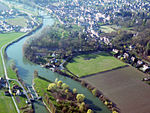Armistice of 22 June 1940

The Armistice of 22 June 1940, sometimes referred to as the Second Armistice at Compiègne, was an agreement signed at 18:36 on 22 June 1940 near Compiègne, France by officials of Nazi Germany and the Third French Republic. It became effective at midnight on 25 June. Signatories for Germany included Wilhelm Keitel, a senior military officer of the Wehrmacht (the German armed forces), while those on the French side held lower ranks, including general Charles Huntziger. Following the decisive German victory in the Battle of France (10 May – 25 June 1940) during World War II, this armistice established a German occupation zone in Northern and Western France that encompassed about three-fifths of France's European territory, including all English Channel and Atlantic Ocean ports. The remainder of the country was to be left unoccupied, although the new regime that replaced the Third Republic was mutually recognised as the legitimate government of all of Metropolitan France except Alsace–Lorraine. The French were also permitted to retain control of all of their non-European territories. Adolf Hitler deliberately chose Compiègne Forest as the site to sign the armistice because of its symbolic role as the site of the Armistice of 11 November 1918 that signaled the end of World War I with Germany's surrender.
Excerpt from the Wikipedia article Armistice of 22 June 1940 (License: CC BY-SA 3.0, Authors, Images).Armistice of 22 June 1940
Route du Maréchal Foch, Compiègne
Geographical coordinates (GPS) Address Nearby Places Show on map
Geographical coordinates (GPS)
| Latitude | Longitude |
|---|---|
| N 49.4275 ° | E 2.9061111111111 ° |
Address
Clairière de l'Armistice (Clairière de Rethondes)
Route du Maréchal Foch
60200 Compiègne
Hauts-de-France, France
Open on Google Maps







